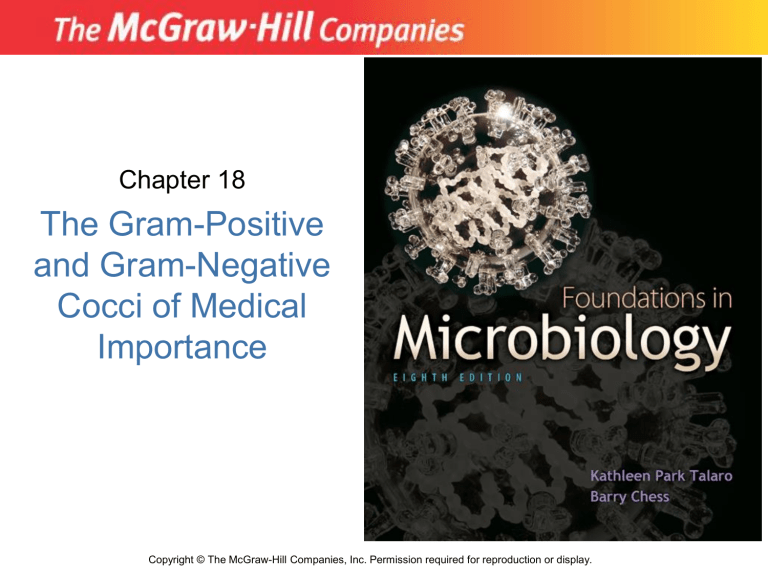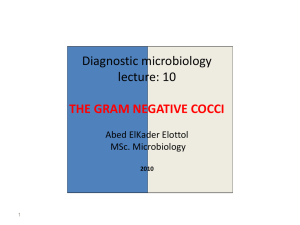S. pneumoniae

Chapter 18
The Gram-Positive and Gram-Negative
Cocci of Medical
Importance
Copyright © The McGraw-Hill Companies, Inc. Permission required for reproduction or display.
Treatment and Prevention
• Groups A and B are treated with penicillin
• Long-term penicillin prophylaxis for people with a history of rheumatic fever or recurrent strep throat
• Enterococcal treatment usually requires combined therapy
2
a
-Hemolytic Streptococci:
Viridans Group
• Large complex group
– Streptococcus mutans, S. oralis, S. salivarus,
S. sanguis, S. milleri, S. mitis
• Most numerous and widespread residents of the gums and teeth, oral cavity, and also found in nasopharynx, genital tract, skin
• Not very invasive; dental or surgical procedures facilitate entrance
3
Viridans Group
• Bacteremia, meningitis, abdominal infection, tooth abscesses
• Most serious infection – subacute endocarditis –
Blood-borne bacteria settle and grow on heart lining or valves
• Persons with preexisting heart disease are at high risk
• Colonization of heart by forming biofilms
4
Viridans Group
• S. mutans produce slime layers that adhere to teeth, basis for plaque
• Involved in dental caries
• Persons with preexisting heart conditions should receive prophylactic antibiotics before surgery or dental procedures
5
Streptococcus pneumoniae :
(Pneumococcus)
• Causes 60-70% of all bacterial pneumonias
• Small, lancet-shaped cells arranged in pairs and short chains
• Culture requires blood or chocolate agar & growth improved by 5-10% CO
2
• Lack catalase and peroxidases – cultures die in O
2
Copyright © The McGraw-Hill Companies, Inc. Permission required for reproduction or display.
6
CDC
S. pneumoniae
• All pathogenic strains form large capsules – major virulence factor
• Specific soluble substance (SSS) varies among types
• 90 different capsular types have been identified
• Causes pneumonia and otitis media
7
Epidemiology and Pathology
• 5-50% of all people carry it as normal flora in the nasopharynx; infections are usually endogenous
• Very delicate, does not survive long outside of its habitat
• Young children, elderly, immune compromised, those with other lung diseases or viral infections, persons living in close quarters are predisposed to pneumonia
• Pneumonia occurs when cells are aspirated into the lungs of susceptible individuals
• Pneumococci multiply and induce an overwhelming inflammatory response
• Gains access to middle ear by way of Eustachian tube
8
S. pneumoniae and Pneumonia
Copyright © The McGraw-Hill Companies, Inc. Permission required for reproduction or display.
Capsule Cell
Pneumococci
Exudate
Bronchus
Bronchiole
9
Alveoli
S. pneumoniae and Otitis Media
Copyright © The McGraw-Hill Companies, Inc. Permission required for reproduction or display.
External ear canal
Eardrum
(bulging)
Inflammator y exudate
Eustachain tube
(inflamed) From upper respiratory secretions
(a)
© Clinica Claros/Phototake
(b)
© Clinica Claros/Phototake
10
Cultivation and Diagnosis
• Gram stain of specimen – presumptive identification
• Quellung test or capsular swelling reaction
• α-hemolytic; optochin sensitivity, bile solubility, inulin fermentation
11
Treatment and Prevention
• Traditionally treated with penicillin G or V
• Increased drug resistance
• Two vaccines available for high risk individuals:
– Capsular antigen vaccine for older adults and other high risk individuals – effective 5 years
– Conjugate vaccine for children 2 to 23 months
12
Concept Check:
Streptococcus pneumoniae bacterial pneumonia is highly contagious.
A. True
B. False
Family Neisseriaceae
• Gram-negative cocci
• Residents of mucous membranes of warmblooded animals
• Genera include Neisseria and Moraxella
• 2 primary human pathogens:
– Neisseria gonorrhoeae
– Neisseria meningitidis
14
Genus Neisseria
• Gram-negative, bean-shaped, diplococci
• None develop flagella or spores
Copyright © The McGraw-Hill Companies, Inc. Permission required for reproduction or display.
• Capsules on pathogens
• Pili
• Strict parasites, do not survive long outside of the host
• Aerobic or microaerophilic
• Produce catalase and cytochrome oxidase
• Pathogenic species require enriched complex media
© Charles C. Brinton, Jr., John A. Tainer, Michael E. Piques and Lisa Craig
15
Neisseria gonorrhoeae:
(Gonococcus)
• Virulence factors:
– Fimbriae , other surface molecules for attachment; slows phagocytosis
– IgA protease – cleaves secretory
IgA
16
Epidemiology and Pathology
• Strictly a human infection
• In top 5 STDs
• Infectious dose 100-1,000
• Does not survive more than 1-2 hours on fomites
Copyright © The McGraw-Hill Companies, Inc. Permission required for reproduction or display.
Gonorrhea and Syphilis —Reported Rates: United States, 1970—2009
500
Gonorrhea
Syphilis
400
300
200
100
50
0
1970 73 76 79 82 85 88
Year
91 94 97 2000 2003 2006 2009
17
Gonorrhea
• Males – urethritis , yellowish discharge, scarring, and infertility
– 10% of males are asymptomatic
Copyright © The McGraw-Hill Companies, Inc. Permission required for reproduction or display.
Normal Gonorrhea
Urinary bladder Ureter
Vas deferens
Seminal vesicle
Prostate gland
Penis
Epididymis
Testis
Site of infection
Urethral opening
(a)
Urethra
Scar tissue
(b)
Image courtesy of the Centers for Disease Control and Prevention, Renelle Woodfall
18
Gonorrhea
• Females – vaginitis, urethritis, salpingitis
(PID) mixed anaerobic abdominal infection, common cause of sterility and ectopic tubal pregnancies
– 50% of females are asymptomatic
Copyright © The McGraw-Hill Companies, Inc. Permission required for reproduction or display.
Normal Gonorrhea
Ectopic (tubal) pregnancy
Scar tissue
Fallopian tube
Anaerobic infection
Fimbriae
Ovary Uterus
Peritoneum
Cervix
19
Gonorrhea in Newborns
• Infected as they pass through birth canal
• Eye inflammation , blindness
• Prevented by prophylaxis immediately after birth
20
Diagnosis and Control
• Gram stain – Gram-negative intracellular (neutrophils) diplococci from urethral, vaginal, cervical, or eye exudate – presumptive identification
• 20-30% of new cases are penicillinase-producing PPNG or tetracycline resistant TRNG
• Combined therapies indicated
• Recurrent infections can occur
• Reportable infectious disease
Copyright © The McGraw-Hill Companies, Inc. Permission required for reproduction or display.
Gonococci
© George J. Wilder/Visuals Unlimited
Neutrophil
21
Neisseria meningitidis:
(Meningococcus)
Virulence factors:
– Capsule
– Adhesive fimbriae
– IgA protease
– Endotoxin
• 12 strains; serotypes A, B, C cause most cases
22
Epidemiology and Pathogenesis
• Prevalent cause of meningitis ; sporadic or epidemic
• Human reservoir – nasopharynx; 3-30% of adult population; higher in institutional settings
• High risk individuals are those living in close quarters, children 6 months-3 years, children and young adults
10-20 years
• Disease begins when bacteria enter bloodstream, cross the blood-brain barrier, permeate the meninges, and grow in the cerebrospinal fluid
• Very rapid onset; neurological symptoms; endotoxin causes hemorrhage and shock; can be fatal
23
Meningococcus Infection
Copyright © The McGraw-Hill Companies, Inc. Permission required for reproduction or display.
Cerebrospinal fluid
Meninges
Nasal cavity
Initial infection site
Palate
24
Clinical Diagnosis
• Gram stain CSF, blood, or nasopharyngeal sample
• Culture for differentiation
• Rapid tests for capsular polysaccharide
25
Treatment and Prevention
• Treated with IV penicillin G, cephalosporin
• Prophylactic treatment of family members, medical personnel, or children in close contact with patient
• Primary vaccine contains specific purified capsular antigens
26
The Gram-Negative Cocci
27
Other Gram-Negative Cocci and
Coccobacilli
• Genus Moraxella
– Bacilli – found on mucous membranes
– M. (formerly Branhamella) catarrhalis – found in nasopharynx: significant opportunist in cancer, diabetes, alcoholism. Considered an emerging human pathogen; it has been identified as an important cause in bronchopulmonary infection.
• Genus Acinetobacter
28
Concept Check:
A common cause of meningitis in young adults is found in the genus
A. Streptococcus
B. Staphylococcus
C. Neisseria
D. Branhamella








